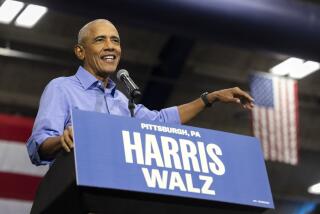Obama’s attacks on Romney causing collateral damage
- Share via
DAYTON, Ohio -- President Obama gained ground by employing harshly negative tactics against Mitt Romney, but that strategy has a downside: it is complicating the president’s efforts to generate turnout among younger voters, a crucial part of his coalition.
Faced with a bad economy and a tough re-election battle, Obama obviously felt he had no other choice. But his decision to go heavily negative is a repudiation of the brand of politics he espoused in 2008 that pulled in hordes of under-30 voters.
A main purpose of negative campaigning is vote suppression. Obama’s current messaging is designed to discourage turnout among blue-collar whites, a group he has long struggled to attract, veteran journalist Tom Edsall recently argued.
“The negative ads run by the Obama campaign and its allied “super PAC,” Priorities USA — ads demonizing Romney — target not only whites without college degrees, but in particular white men without degrees, a constituency Obama has no hope of winning,” wrote Edsall, who has been studying race and class in American politics for more than 30 years.
Here in western Ohio, a state hit hard by the loss of manufacturing jobs, months of attack ads — particularly one that ridicules Mitt Romney’s singing of “America the Beautiful,” while accusing him of helping to ship U.S. jobs overseas — have turned off many voters, including ardent Obama supporters.
“I don’t like the way the campaign is going, to tell you the truth. It’s way too negative,” said Laurie Leach, 64, a retired teacher attending a campaign rally in Dayton headlined by Michelle Obama. The Obama backer said she recognizes that the president is in “a really difficult position” politically but said the campaign “should be a different kind of discussion.”
Though Obama’s main objective may be to discourage working-class whites from supporting Romney, negative TV advertising can never be surgically targeted. Inevitably, there is spillover.
In this election, the collateral damage could be particularly severe among a key Obama demographic -- younger voters.
Historically, young voters make up the age group that is least likely to participate in elections. But in 2008, Obama went to great lengths to appeal for their support. His success in portraying himself as a different kind of politician gave him a big edge among those aged 18-30 (even though he was not above using negative tactics in that campaign, either. At a key moment in the fall, Obama twisted John McCain’s comments about the economy out of context to make the Republican appear out of touch with ordinary voters).
This time, reduced enthusiasm among younger voters was already being factored into turnout projections, a result of Obama’s failure to meet the high expectations he generated in 2008.
But the president’s negative campaign could well make that turnout drop worse. A 21-year-old Democratic canvasser, collecting signatures for a ballot measure to take redistricting power away from the state legislature, said he will cast his first vote for president this fall for Obama. But after deploring the tone of the campaign, he also observed that most of his friends have little or no interest in the election.
There is more than enough time left for Obama to change that tone. He may have taken an initial step in that direction this week with a new ad in which he acknowledges that “sometimes politics can seem very small.”
But overcoming the alienation produced by his own negative campaign tactics will likely make Obama’s efforts to motivate and mobilize younger voters more difficult than before.
Follow Politics Now on Twitter
Twitter: @paulwestdc
More to Read
Get the L.A. Times Politics newsletter
Deeply reported insights into legislation, politics and policy from Sacramento, Washington and beyond. In your inbox three times per week.
You may occasionally receive promotional content from the Los Angeles Times.










